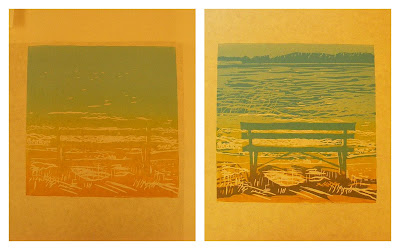Why is that shark attacking the duck? All is explained at the foot of this post.
On day 4 of the printmaking class, we began working on a collaborative print. Two prints from the edition will be presented to benefactors of the ICCA building, at a ceremony in July. After consultation with Matthew, the Director of the ICCA, we agreed on some images that symbolise the Interlochen campus, this beautiful place situated between two lakes in the woods of northern Michigan. As I wandered around the grounds looking for inspiration, two things struck me: the big stones that were used in the construction of the smallest rehearsal studios and the largest, newest buildings; and the green benches that are scattered around the hundreds of acres of the campus. These benches used to be the seating in the giant open-air auditorium, I believe. I found one sitting on the shore of the bigger of the two lakes, which made a great picture with a lot of contrast in it. After all agreeing on the subject matter, we got to work cutting the blocks.
Ava took the image of the stone rehearsal studio, and I took the one of the bench in front of the lake. After a day and a half of setting up, preparing the registration rigs, cutting, proofing, and starting on the edition, we ended up on Thursday night with five prints from each one. Here is Ava's (first stage on the left, second on the right):
Then here's mine. I did a three-colour rainbow roll on each of the two stages, so the image on the right is already at six colours:
On Friday, the last day of the class, we will finish cutting and adding two more layers of colours.
We were so pleased with how this came out that we felt we had to go to Hofbrau's, one mile north of the campus, to celebrate with some toy drinks. I got the 'Rubber Ducky Your (sic) the One', which came with a free rubber duck:
... and Patty got the Sharkarita:
As you can see, the excellent rubber shark was already attacking Patty's straw before she could even taste her drink. It was only a matter of time before the duck became shark meat ...




